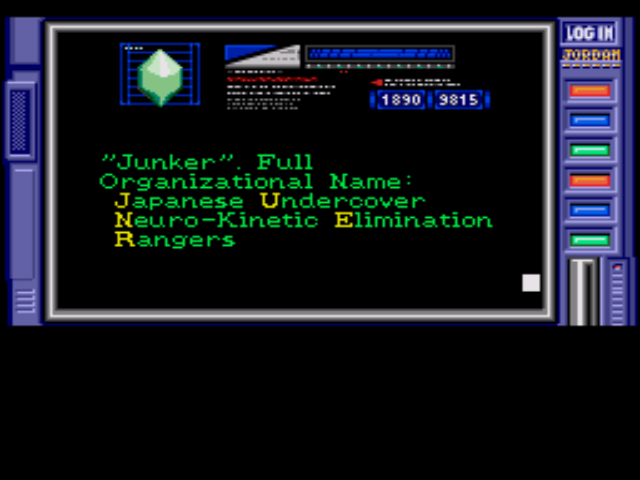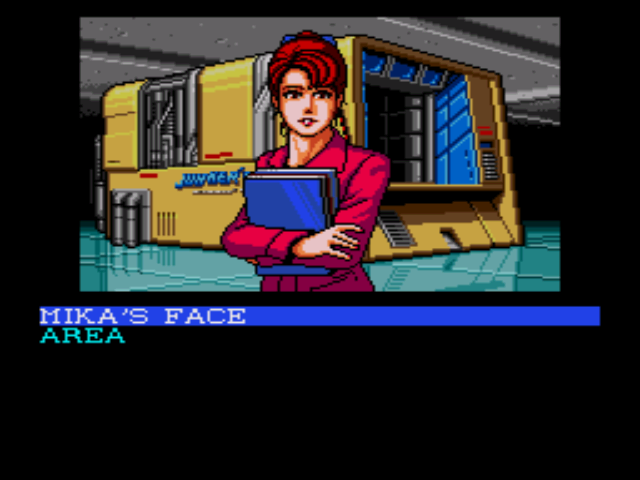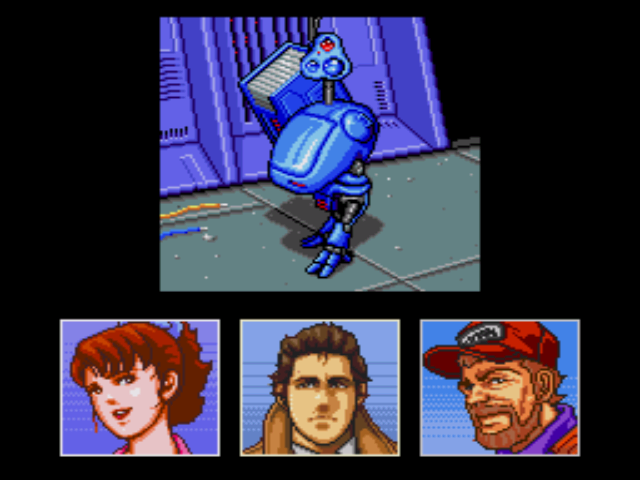Snatcher doesn’t just run with blades.
For a game that was initially released more than 20 years ago, 1988 to be precise, Snatcher turned out to be surprisingly super effective on my mind. All I knew was this game revolved around artificial intelligence, cyborgs, all those areas that I’m interested in (cyberpunk) and of course, I knew that it was a Hideo Kojima game. Everything about it was something that I really liked. The most common statement from anyone recommending this game was: “It’s like Blade Runner”. Blade Runner is of course a great movie by itself, but Snatcher turned out to be an experience far more memorable than the movie, not only for the obvious “interaction” that it offers as a game, but for many other reasons which I would like to elaborate on in my analysis.
Over the course of time, the game had many adjustments, improvements, to suit different market regions and systems it was released for. Originally released on the PC-8801 and MSX2 in 1988 Japan, the game was re-released on systems as late as 1996. Which raises questions such as…
- The developers must have really loved the game to release it in all these systems.
- The game should have been really good for having been supported by publishers many times.
and many other questions surrounding its multiple releases and its cult-classic status. I played the Sega CD version, which is probably the most popular version of the game. It had “High Quality” written all over it.
The game starts off with an intro that pretty much sets the tone for the whole game. It introduces you to the premise, “Great Disaster”, “Neo Kobe” (melting pot of Japan), “Body Snatching Cyborgs”, are the main points to note. But more than that, the way it is presented, with a really good voice over (narration) and BGM, really makes the whole intro worth watching, again and again. Once the initial premise is set, you are then introduced to Neo Kobe. With the Jazzy saxophones of “One Night in Neo Kobe” playing in background, the sprawling city of Neo Kobe is given life in what is arguably one of the most memorable intros I’ve seen in my 18 years of playing games.
For a moment you forget that the visuals of the game are in low-res 2D graphics, the combination of music and visuals excites the players’ imagination, creating an immersive and believable world. Once the intro credits finish rolling, you are introduced to the amnesic protagonist Gillian Seed and his wife Jamie. Having no clue of their past, the couple decide to separate and discover their past so that they can have a meaning to their relation and existence. Gillian decides to be a runner for the JUNKER organization which deals with the Snatcher menace.
For a game made in Japan, the character art style suits the style of anime that were out during the late 80s. Which is not similar to the present day anime in the sense that the characters do not have the prominent “anime eye” or “moe” style of design to them that is found in modern day anime. Being a futuristic world, a time when artificially intelligent robots have become integral part of human life; it has many interesting characters, memorable conversations  and interactions. The OST of the game, complements it completely. The oft-mechanical, sometimes weird, sounds accompanied by melodic/atmospheric BGMs speak just like the characters in the game.
and interactions. The OST of the game, complements it completely. The oft-mechanical, sometimes weird, sounds accompanied by melodic/atmospheric BGMs speak just like the characters in the game.
The game has you playing as Gillain Seed, it works like a detective story. You try to find clues that would help you in solving the mystery of fellow JUNKER “runner” Jean Jack Gibson’s death, eventually revealing the explanation for the Snatcher menace and your past. It is a Kojima game through and through. Every female character in the game is exceptionally beautiful and it plays like a dating-sim at parts. Whenever you talk to a female character you have a chance to ask them out on a date. At one point, when you are investigating Gibson’s apartment, you can try and ask his daughter Katrina out on a date, when done multiple times, she kicks you out of the house and you cannot enter the house until you knock on the door multiple times.
This is a point where the creator tried to test the player’s mind. After getting kicked out of the house, you do not gain the trust of Katrina immediately, you need to knock multiple times and talk to her to prove that you will behave yourself. After the first denial of entry, the player would usually try to think of some other way of getting in instead of knocking again. But if the game had effectively immersed the player into character, s/he would have tried to knock again and again in desperation just like as if in real life, which indeed does lead to the result. Gillian is a lover-boy who keeps flirting with every woman he comes across. The conversations between Gillian and the ladies, although mainly irrelevant to the progress of the game’s story, add a lot of depth to the characters. They are very well written and feel very human, no wonder Kojima-san contributed to Tokimeki Memorial games in the future, he seems to have a knack for such things.
The gameplay is like that of classic adventure games, but instead of making you pixel-hunt, the game gives you an exhaustive list of verbs and then a sub-menu that is your only option for the chosen verb. A player could just try each and every option one after the other when stuck to cheat out of the game. Even if the player doesn’t want to cheat, one will find themselves trying every option anyways, just to see what Gillian has to say about things. There are shooting sections in the game when the game shifts to first person mode and you fire the gun using the d-pad for a 3×3 square of possible targets (or an actual gun with the original peripherals). The later stages require you to have very quick reflexes for optimum performance.
The story is pretty long (~15h), it deals with many questions about a future world where humans and robots will (barely) co-exist.
- It deals with trust. (Are you talking to a human or a robot in disguise?)
- It shows a world which is handicapped by technology . (automated traffic systems)
- A world that would be controlled with information tracking. (Profiles of every citizen in database)
- How would you treat a sentient robot. (Will it just be a tool, or a fellow being?)
 In addition to all these and many other topics covered by the game, it most importantly shows (or at least that is how I perceived it to be) how love is the root cause of everything, be it of life-giving happiness or world-destroying agony. All these topics are very similar to those in other Kojima games, especially the Metal Gear Solid series. Everything shown in this game is in some breadth covered across the 4 main games of the MGS series.
In addition to all these and many other topics covered by the game, it most importantly shows (or at least that is how I perceived it to be) how love is the root cause of everything, be it of life-giving happiness or world-destroying agony. All these topics are very similar to those in other Kojima games, especially the Metal Gear Solid series. Everything shown in this game is in some breadth covered across the 4 main games of the MGS series.
Which brings us to one interesting tidbit. The Metal Gear Mk.ii which is the remote controlled assistant of Old Snake in MGS4, is one of the central characters in Snatcher, it is the assistant of Gillian. A talking R2D2, a really witty one at that. The conversations between Gillian and Metal Gear are some of the best buddy-comedy lines you can expect to see in a game. Everything feels so real, if there was a robot that could talk back to you and be funny at the same time, your best bet is that it would talk like Metal Gear.
The locations of Neo Kobe covered in Snatcher are just as diverse as the characters in the game. There is the black market area, a Times Square area, a club, among other places. The attention to detail for the things in the world is also amazing, you have pages of information about fictional characters that you hardly meet in the game. The Central database also has an interesting Easter Egg where you can type in “Hideo Kojima” and you get his info with a small message. You can also find out how the furniture of the future might be made, and probably how scary the future of centralized information control (SSN, Credit score etc) can get. The technical jargon in all the dialogues is not something that is only there to sound “cool”, all what the characters say make it all feel very real.
It asks a lot of important questions, shows us a world that our world might become.
- Would you want to live a world where you are a criminal if you refuse to tell everything about yourself to the government?
- Can you identify a person based on a decomposed body, in under a minute?
- Would you want to know if you are in love with a human or a robot?
- Does the world really need a toilet that gives instant stool analysis?
Snatcher is a game that anyone who is interested in an enticing experience will enjoy. If someone does not like reading and… not-shooting in a game, they might be turned off, but the possible thoughts of maybe going out on a date with your in-game wife might keep them hanging till the “good part” starts. You can end up spending hours just reading through all the information in the central computer about Snatcher’s world, or talking to random people by calling numbers you get off of flyers and bulletin boards. There are numerous ways to play and enjoy Snatcher, no matter what you do, you will end up having a very satisfying and memorable time.
Articles in this series
Game Studies
- Snatcher doesn’t just run with blades. (Now Reading)





